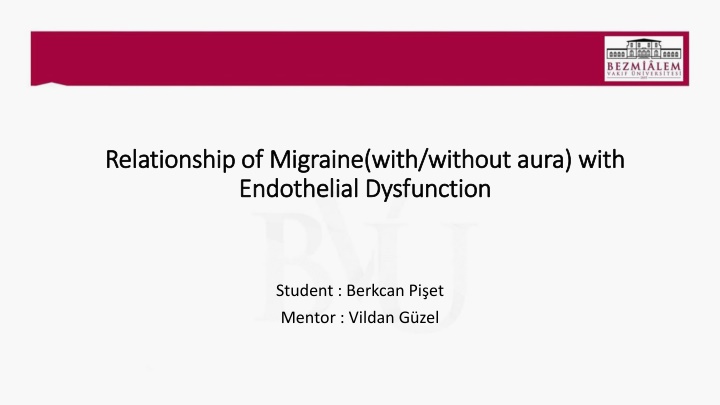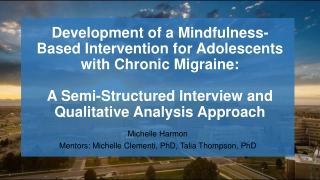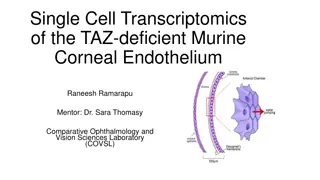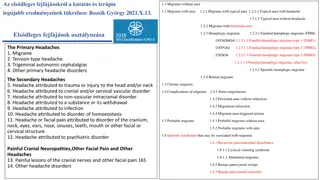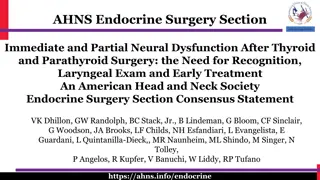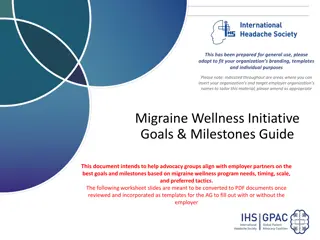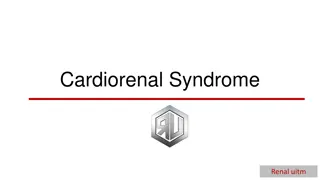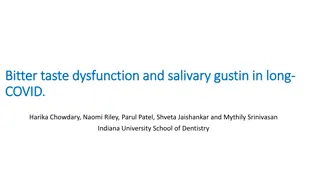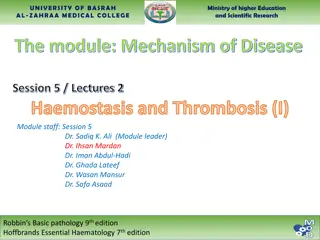Migraine with Endothelial Dysfunction
Migraine is a chronic disease affecting 15% worldwide, characterized by severe headaches with social and economic impacts. This study aims to understand the pathophysiology of migraine for future treatment advancements. Two groups participated - one with migraine aura and the other as volunteers. Blood samples were taken to examine coagulation and inflammation markers. Results showed a gender distribution and group details.
Download Presentation

Please find below an Image/Link to download the presentation.
The content on the website is provided AS IS for your information and personal use only. It may not be sold, licensed, or shared on other websites without obtaining consent from the author.If you encounter any issues during the download, it is possible that the publisher has removed the file from their server.
You are allowed to download the files provided on this website for personal or commercial use, subject to the condition that they are used lawfully. All files are the property of their respective owners.
The content on the website is provided AS IS for your information and personal use only. It may not be sold, licensed, or shared on other websites without obtaining consent from the author.
E N D
Presentation Transcript
Relationship Relationship of of Migraine Migraine( (with Endothelial Endothelial Dysfunction Dysfunction with/ /without without aura aura) ) with with Student : Berkcan Pi et Mentor : Vildan G zel
What is What is migraine migraine? ? Migraine is a chronic disease that affects approximately 15% of the population worldwide. Migraine is characterized by recurrent moderate or severe headaches. Migraine has serious negative effects on the social and economic functionality of a person.
What What causes causes migraines migraines? ? Although it's a fairly common illness people suffer from, there is no clear evidence as to what causes it Genetics and environmental factors appear to play a role.
What is our goal in this study? What is our goal in this study? Our research is aimed at better understanding the pathophysiology of migraine. Thus contributing to future prophylaxis, treatment and etiology studies by obtaining information about the mechanisms by which migraine is effective.
Material Material/ /Method Method Two groups participated in our study.First group included migraneurs aura.Second group included volunteers. Blood samples were taken Coagulation and inflammation markers were examined from the samples. with and without Inclusion Criteria Being eligible for the category of migraine in the International Headache Society ICHD-3 migraine classification scale from both groups. In order to observe the coagulation ,Prothrombin time (PT), Activated Partial Prothrombin Time (aPTT) levels were measured. Suffering from any infectious diseases, hematological diseases, cardiovascular diseases, immune insufficiency. Anticoagulant drug use Use of nonsteroidal anti-inflammatory drugs or antiplatelet drugs 1 week before the test History of cardiovascular and cerebrovascular disease Pregnancy Being physically unfit to donate blood Exclusion Criteria C-reactive protein (CRP) levels were used as a biomarker to measure inflammation in the endothelium. All comparison between groups. collected results were recorded for
Results Results Gender 30 20 Male 10 Female 0 18-30 Age distribution in migraine group 30-40 40-50 50-60 15 10 Male 5 Female 0 18-30 30-40 40-50 50-60 Male Female Age distribution in volunteer group
Results Results 120 people participated in our study. 70.8% were female, 29.2% were male. 80 participants were in the migraine group. 40 participants were in the control group formed by volunteers. Average age in migraneurs was 36.3 years. In control group it was 34.7 years.
Results Results Migraineurs (n=80) Control group (n=40) P-value COAGULATION Prothrombin time(PT) Mean:13,82 SD:0,67 Mean:14,33 SD:0,83 0,004 Activated Partial Prothrombin time (aPTT) 0,57 Mean:29,98 SD:4,25 Mean:30,41 SD:3,22 INFLAMMATION C-reactive protein (CRP) Mean:1,63 SD:1,42 0,02 Mean:1,02 SD:1,12
Results Results After evaluating the samples of C-reactive protein (CRP) levels and Prothrombin time(PT) a significant difference between migraineurs and control group was found. Serum CRP levels were increased in migraineurs compared with controls In contrast to CRP,Prothrombin times were decreased in migraineurs compared with controls. Another marker in our study Aptt value was statistically insignificant between both groups
Conclusion Conclusion The results of this study suggest that migraine disease severely impair endothelial function by damaging coagulation and inflammation mechanisms. This impairment may lead migraineurs to become more susceptible to cardiovascular and cerebrovascular problems.
References References 1.Olesen, J., Thomsen, L. L., & Iversen, H. Nitric oxide is a key molecule in migraine and other vascular headaches. Trends Pharmacol Sci.1994;15, 149 153. 2.Olesen, J. The role of nitric oxide (NO) in migraine, tension-type headache and cluster headache. Pharmocology & Therapeutics. 2008;120, 157-171. 3.Tietjen GE, Herial NA,White L, Utley C, Kosmyna JM, Khuder SA. Migraine and biomarkers of endothelial activation in young women. Stroke. 2009;40, 2977-2982. 4.Tietjen, GE., Khubchandani, J., Herial, NA., Shah, K. Adverse Childhood Experiences Are Associated With Migraine and Vascular Biomarkers.Headache. 2012;52 , 920-929.
